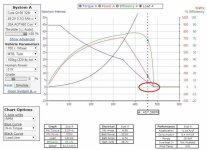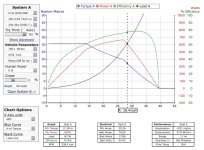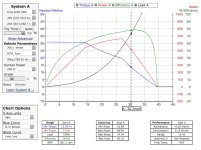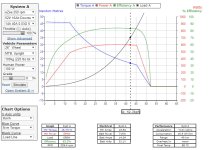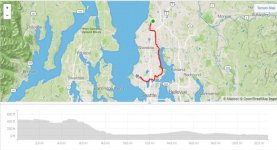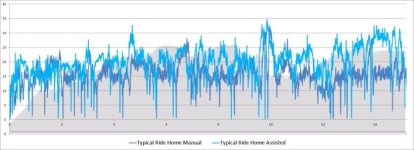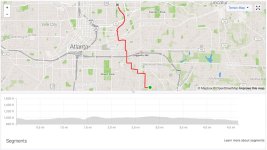molybdenum
1 kW
I think that EM3EV puts much better workmanship into their batteries, and you can't go wrong there.
One thing worth considering is the ease of battery removal. The bottle batteries slide out of the mounting bracket easily, whereas the triangle battery must be unzipped from the bag and disconnected from the leads. This is accomplished more easily if the connectors from battery to controller are inside the bag so you don't have to feed it through. Of course, you could leave the battery in the bag and charge it on the bike if this works for you. You may want to remove the battery from the bag to prevent theft unless you have secure storage at work. Removing the battery will take a bit longer and pose a slightly higher risk of accidentally dropping the battery when removing it. I've dropped my bottle battery twice over the years (and also done a couple laydowns) and now there's stuff rattling around inside - still works though.
Given that you are a strong cyclist with a flat quiet commute and plan for a larger battery, my vote would be for the faster 328RPM@48V. if you want the higher top speed, you'll certainly achieve it with this setup - and you have to ask yourself if you really want the higher top speed. In addition to topography and traffic patterns, this also depends on road quality/smoothness as well as your comfort zone. The only caveat with this setup is that you have to keep your motor RPM above 50% of unloaded on long ascents or you will overheat and burn out the motor. With a faster motor, 50% of top speed is higher and you have less torque on hills, which can compound the problem. If you can't sustain 50% of unloaded speed at full power, it's better to feed minimal power, gear down and grind. Short but steep shouldn't be a problem, as the motor takes time to accumulate heat.
As you are a strong cyclist and your setup will be very light and nimble, you'd only need ~600W motor power to push the 328@48V motor well over the unloaded speed of the slower 201RPM@36V version and you'd likely see 5+ kph gains over that of the slower motor. In theory, the battery you link at 862 Wh would be about 80% depleted should you max out your motor at 600W over your entire commute, but should you limit to 600W on uphill sections and use less on gentle descents,your usage would be likely be considerably less. The lower speed setup will always be much more efficient in terms of power required.
According to the sims with a 328RPM@48V motor with ~600W motor power using 52V battery, I think you'd likely get:
42 kph with 100W human power added sitting upright
44 kph with 200W human power sitting upright
47 kph with 200W human power tucked position
Even with 500W motor power, you'd still go faster with the faster wind motor. I'm guessing that the break even point for slower vs faster motor (assuming 100W human power, and I'm guessing) would be around 400W motor power. My initial concerns were that you wouldn't have enough battery power with the smaller 11.5Ah bottle to take advantage of a faster motor, but if you go with the EM3EV 862 Wh battery, you should be fine.
Here's some thoughts on the battery: Your battery will last longer if you limit discharge to 30% of empty. Longest life (possibly double in terms of discharge cycles) can be achieved by charging to 90% and limiting discharge to 30% of empty. Of note, most EM3EV chargers have three charge settings; 100% charge, 90% charge for longevity and 50% for storage charge.
One thing worth considering is the ease of battery removal. The bottle batteries slide out of the mounting bracket easily, whereas the triangle battery must be unzipped from the bag and disconnected from the leads. This is accomplished more easily if the connectors from battery to controller are inside the bag so you don't have to feed it through. Of course, you could leave the battery in the bag and charge it on the bike if this works for you. You may want to remove the battery from the bag to prevent theft unless you have secure storage at work. Removing the battery will take a bit longer and pose a slightly higher risk of accidentally dropping the battery when removing it. I've dropped my bottle battery twice over the years (and also done a couple laydowns) and now there's stuff rattling around inside - still works though.
Given that you are a strong cyclist with a flat quiet commute and plan for a larger battery, my vote would be for the faster 328RPM@48V. if you want the higher top speed, you'll certainly achieve it with this setup - and you have to ask yourself if you really want the higher top speed. In addition to topography and traffic patterns, this also depends on road quality/smoothness as well as your comfort zone. The only caveat with this setup is that you have to keep your motor RPM above 50% of unloaded on long ascents or you will overheat and burn out the motor. With a faster motor, 50% of top speed is higher and you have less torque on hills, which can compound the problem. If you can't sustain 50% of unloaded speed at full power, it's better to feed minimal power, gear down and grind. Short but steep shouldn't be a problem, as the motor takes time to accumulate heat.
As you are a strong cyclist and your setup will be very light and nimble, you'd only need ~600W motor power to push the 328@48V motor well over the unloaded speed of the slower 201RPM@36V version and you'd likely see 5+ kph gains over that of the slower motor. In theory, the battery you link at 862 Wh would be about 80% depleted should you max out your motor at 600W over your entire commute, but should you limit to 600W on uphill sections and use less on gentle descents,your usage would be likely be considerably less. The lower speed setup will always be much more efficient in terms of power required.
According to the sims with a 328RPM@48V motor with ~600W motor power using 52V battery, I think you'd likely get:
42 kph with 100W human power added sitting upright
44 kph with 200W human power sitting upright
47 kph with 200W human power tucked position
Even with 500W motor power, you'd still go faster with the faster wind motor. I'm guessing that the break even point for slower vs faster motor (assuming 100W human power, and I'm guessing) would be around 400W motor power. My initial concerns were that you wouldn't have enough battery power with the smaller 11.5Ah bottle to take advantage of a faster motor, but if you go with the EM3EV 862 Wh battery, you should be fine.
Here's some thoughts on the battery: Your battery will last longer if you limit discharge to 30% of empty. Longest life (possibly double in terms of discharge cycles) can be achieved by charging to 90% and limiting discharge to 30% of empty. Of note, most EM3EV chargers have three charge settings; 100% charge, 90% charge for longevity and 50% for storage charge.


